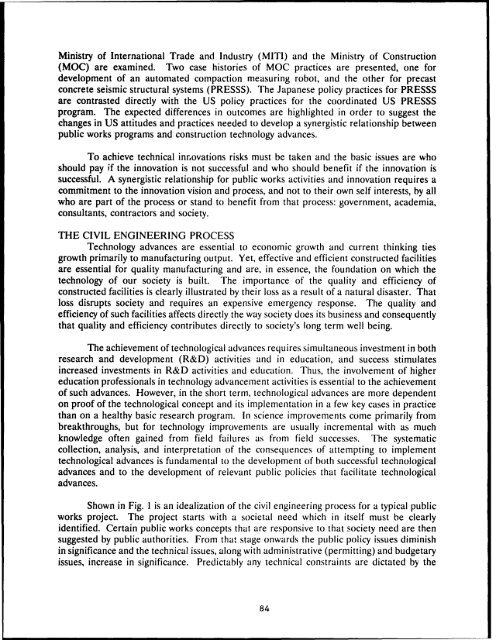Challenges and Opportunities for Innovation in the Public Works ...
Challenges and Opportunities for Innovation in the Public Works ...
Challenges and Opportunities for Innovation in the Public Works ...
Create successful ePaper yourself
Turn your PDF publications into a flip-book with our unique Google optimized e-Paper software.
M<strong>in</strong>istry of International Trade <strong>and</strong> Industry (MITI) <strong>and</strong> <strong>the</strong> M<strong>in</strong>istry of Construction<br />
(MOC) are exam<strong>in</strong>ed. Two case histories of MOC practices are presented, one <strong>for</strong><br />
development of an automated compaction measur<strong>in</strong>g robot, <strong>and</strong> <strong>the</strong> o<strong>the</strong>r <strong>for</strong> precast<br />
concrete seismic structural systems (PRESSS). The Japanese policy practices <strong>for</strong> PRESSS<br />
are contrasted directly with <strong>the</strong> US policy practices <strong>for</strong> <strong>the</strong> coord<strong>in</strong>ated US PRESSS<br />
program. The expected differences <strong>in</strong> outcomes are highlighted <strong>in</strong> order to suggest <strong>the</strong><br />
changes <strong>in</strong> US attitudes <strong>and</strong> practices needed to develop a synergistic relationship between<br />
public works programs <strong>and</strong> construction technology advances.<br />
To achieve technical <strong>in</strong>novations risks must be taken <strong>and</strong> <strong>the</strong> basic issues are who<br />
should pay if <strong>the</strong> <strong>in</strong>novation is not successful <strong>and</strong> who should benefit if <strong>the</strong> <strong>in</strong>novation is<br />
successful. A synergistic relationship <strong>for</strong> public works activities <strong>and</strong> <strong>in</strong>novation requires a<br />
commitment to <strong>the</strong> <strong>in</strong>novation vision <strong>and</strong> process, <strong>and</strong> not to <strong>the</strong>ir own self <strong>in</strong>terests, by all<br />
who are part of <strong>the</strong> process or st<strong>and</strong> to benefit from that process: government, academia,<br />
consultants, contractors <strong>and</strong> society.<br />
THE CIVIL ENGINEERING PROCESS<br />
Technology advances are essential to economic growth <strong>and</strong> current th<strong>in</strong>k<strong>in</strong>g ties<br />
growth primarily to manufactur<strong>in</strong>g output. Yet, effective <strong>and</strong> efficient constructed facilities<br />
are essential <strong>for</strong> quality manufactur<strong>in</strong>g <strong>and</strong> are, <strong>in</strong> essence, <strong>the</strong> foundation on which <strong>the</strong><br />
technology of our society is built. The importance of <strong>the</strong> quality <strong>and</strong> efficiency of<br />
constructed facilities is clearly illustrated by <strong>the</strong>ir loss as a result of a natural disaster. That<br />
loss disrupts society <strong>and</strong> requires an expensive emergency response. The quality <strong>and</strong><br />
efficiency of such facilities affects directly <strong>the</strong> way society does its bus<strong>in</strong>ess <strong>and</strong> consequently<br />
that quality <strong>and</strong> efficiency contributes directly to society's long term well be<strong>in</strong>g.<br />
The achievement of technological advances requires simultaneous <strong>in</strong>vestment <strong>in</strong> both<br />
research <strong>and</strong> development (R&D) activities <strong>and</strong> <strong>in</strong> education, <strong>and</strong> success stimulates<br />
<strong>in</strong>creased <strong>in</strong>vestments <strong>in</strong> R&D activities <strong>and</strong> education. Thus, <strong>the</strong> <strong>in</strong>volvement of higher<br />
education professionals <strong>in</strong> technology advancement activities is essential to <strong>the</strong> achievement<br />
of such advances. However, <strong>in</strong> <strong>the</strong> short term, technological advances are more dependent<br />
on proof of <strong>the</strong> technological concept <strong>and</strong> its implementation <strong>in</strong> a few key cases <strong>in</strong> practice<br />
than on a healthy basic research program. In science improvements come primarily from<br />
breakthroughs, but <strong>for</strong> technology improvements are usually <strong>in</strong>cremental with as much<br />
knowledge often ga<strong>in</strong>ed from field failures as from field successes. The systematic<br />
collection, analysis, <strong>and</strong> <strong>in</strong>terpretation of <strong>the</strong> consequences of attempt<strong>in</strong>g to implement<br />
technological advances is fundamental to <strong>the</strong> development of both successful technological<br />
advances <strong>and</strong> to <strong>the</strong> development of relevant public policies that facilitate technological<br />
advances.<br />
Shown <strong>in</strong> Fig. 1 is an idealization of <strong>the</strong> civil eng<strong>in</strong>eer<strong>in</strong>g process <strong>for</strong> a typical public<br />
works project. The project starts with a societal need which <strong>in</strong> itself must be clearly<br />
identified. Certa<strong>in</strong> public works concepts that are responsive to that society need are <strong>the</strong>n<br />
suggested by public authorities. From that stage onwards <strong>the</strong> public policy issues dim<strong>in</strong>ish<br />
<strong>in</strong> significance <strong>and</strong> <strong>the</strong> technical issues, along with adm<strong>in</strong>istrative (permitt<strong>in</strong>g) <strong>and</strong> budgetary<br />
issues, <strong>in</strong>crease <strong>in</strong> significance. Predictably any technical constra<strong>in</strong>ts are dictated by <strong>the</strong><br />
84







